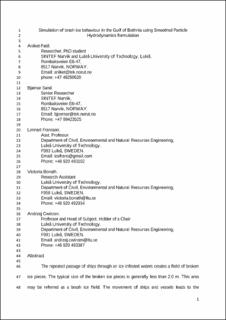| dc.contributor.author | Patil, Aniket | |
| dc.contributor.author | Sand, Bjørnar | |
| dc.contributor.author | Fransson, Lennart | |
| dc.contributor.author | Bonath, Victoria | |
| dc.contributor.author | Cwirzen, Andrzej | |
| dc.date.accessioned | 2021-03-15T09:59:03Z | |
| dc.date.available | 2021-03-15T09:59:03Z | |
| dc.date.created | 2021-03-12T15:01:13Z | |
| dc.date.issued | 2021 | |
| dc.identifier.citation | Journal of cold regions engineering. 2021, . | |
| dc.identifier.issn | 0887-381X | |
| dc.identifier.uri | https://hdl.handle.net/11250/2733338 | |
| dc.description.abstract | The repeated passage of ships through ice-infested waters create a field of broken ice pieces. The typical size of the broken ice pieces is generally <2.0 m. This area might be referred to as a brash ice field. The movement of ships and vessels leads to the transportation and accumulation of broken ice pieces in a brash ice field. A better understanding of the properties and behavior of brash ice could improve the estimates of ice load that are associated with shipping in a brash ice field. An in situ test referred to in this study as a pull up test will be performed in Luleå harbor, Luleå, Sweden. An attempt will be made to estimate the mechanical and physical properties of a brash ice field based on the in situ test results. The test setup, procedure, and test results will be described in detail. Furthermore, the test will be simulated using the smoothed particle hydrodynamics (SPH) formulation. The numerical simulations will calibrate the numerical and material model of brash ice using the pull up test measurements. In this numerical model, a discrete mass-spring-dashpot model will be used to simulate buoyancy and drag. The continuous surface cap model (CSCM) will be used as a material model for the brash ice. The elastic modulus and the fracture energy of brash ice as a material model input will be estimated by an ad hoc scaling formula. The parameters, such as void fraction (Vf), cohesion (c), and angle of internal friction (φ) will be altered to assess their influence on the test data. The analysis of the in situ test results and the simulation results provide a preliminary approach to understand the brash ice failure process that could be further developed into modeling techniques for marine design and operations. | |
| dc.language.iso | eng | |
| dc.subject | Friction coefficient | |
| dc.subject | Friction coefficient | |
| dc.subject | Pull up test | |
| dc.subject | Pull up test | |
| dc.subject | Brash ice | |
| dc.subject | Brash ice | |
| dc.subject | Discrete beam element | |
| dc.subject | Discrete beam element | |
| dc.title | Simulation of brash ice behaviour in the Gulf of Bothnia using Smoothed Particle 1 Hydrodynamics formulation | |
| dc.type | Peer reviewed | |
| dc.type | Journal article | |
| dc.description.version | acceptedVersion | |
| dc.subject.nsi | VDP::Offshoreteknologi: 581 | |
| dc.subject.nsi | VDP::Offshore technology: 581 | |
| dc.source.pagenumber | 14 | |
| dc.source.journal | Journal of cold regions engineering | |
| dc.identifier.doi | 10.1061/(ASCE)CR.1943-5495.0000245 | |
| dc.identifier.cristin | 1897718 | |
| dc.relation.project | Norges forskningsråd: 195153 | |
| dc.relation.project | Andre: Port of Luleå | |
| dc.relation.project | Andre: SSPA Sweden AB | |
| dc.relation.project | Andre: Luleå tekniska universitet | |
| cristin.ispublished | true | |
| cristin.fulltext | postprint | |
| cristin.qualitycode | 1 | |
